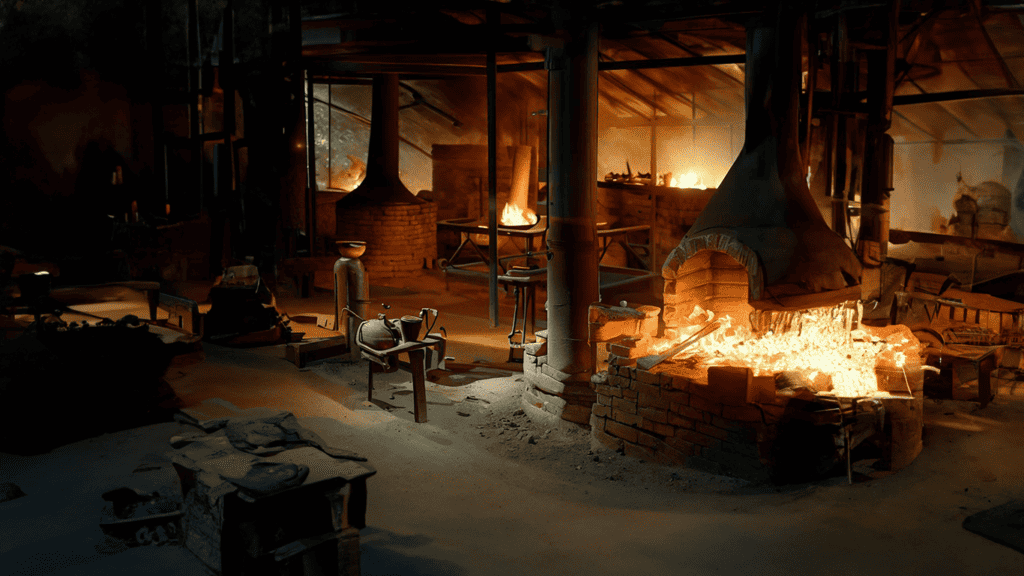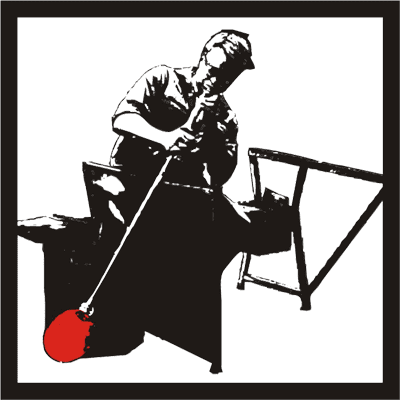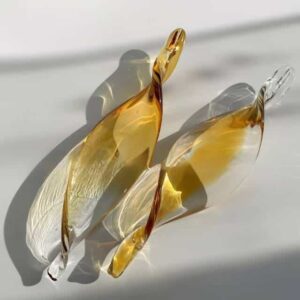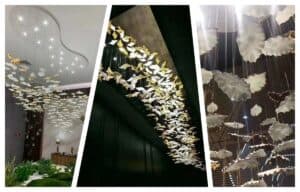Handblown Glass Artistry: Navigating the Nuances of Modern and Classic Designs
Published on 2023年 8月 26日 by iartglass

Introduction
Handblown glass has long been a testament to mankind’s affinity for art and craft. Originating over 2,000 years ago in the regions of Mesopotamia, this art form gradually spread to ancient Rome, the Middle East, and eventually took root in the heart of Europe. The process, which involves inflating molten glass into a bubble with the aid of a blowpipe, has seen minimal changes over centuries, preserving its authentic charm.
This time-honored craft holds a special allure, seamlessly bridging the gap between ancient art and contemporary design. While many traditional art forms have seen a decline in today’s digitized age, handblown glass remains a favored choice for many interior designers, artists, and homeowners. A major factor contributing to its sustained relevance is its ability to adapt and evolve with changing design sensibilities, offering something for everyone. In the vast world of handblown glass, understanding the nuances between design styles can enrich one’s appreciation and enhance purchasing decisions.
From the illustrious pieces showcased in palaces to the contemporary designs gracing modern homes, handblown glass has woven its narrative across epochs. At the heart of this journey lies a deeper significance – recognizing the balance between preserving tradition and embracing innovation. The world-renowned Siga Art Glass stands as a testament to this balance, combining age-old techniques with forward-thinking designs.
Comparison between Classic and Modern design styles in handblown glass artistry.
The Essence of Classic Handblown Glass
Definition and Characteristics
Classic handblown glass can be described as pieces that adhere to traditional techniques, shapes, and designs passed down through generations. Key characteristics include:
- Patterns: Often symmetrical with detailed motifs inspired by nature or historical events.
- Colors: Typically subdued, drawing from a palette of earth tones, muted blues, and soft greens.
- Shapes: Classic shapes such as vases, bowls, and decorative objects often boasting curvilinear forms and intricate detailing.
Traditional Techniques Used
The craft of classic handblown glass is rooted in age-old methods. Some primary techniques include:
- Gathering: Collecting molten glass at the end of a blowpipe.
- Marvering: Shaping the glass using a flat, metal surface.
- Blowing: Introducing air into the glass to form a bubble.
- Puntying: Attaching a secondary rod to support the glass during shaping.
- Annealing: Slowly cooling the glass to relieve internal stresses.
For those keen to delve deeper into these traditional techniques, Unlocking the Art of Hand-blown Glass: A Buyer’s Guide to Lamp Parts Selection provides an exhaustive exploration.
Popular Classic Pieces and Their Significance
Over the years, certain classic pieces have stood out, becoming symbols of elegance and artistry. Some notable ones include:
- Murano Chandeliers: Hailing from the Venetian island of Murano, these chandeliers are renowned for their intricate designs and vibrant colors.
- Bohemian Vases: Celebrated for their detailed enamel work and rich hues.
- Roman Bottles: Recognizable by their slender necks and spherical bodies, often used to store precious oils and perfumes.
The lasting appeal of these classic pieces lies not just in their beauty but in the stories they tell — tales of civilizations, dynasties, and the artisans who breathed life into them. Delving into The Timeless Elegance of Hand-blown Glass: From Ancient Craft to Modern Masterpieces at Siga Art Glass offers a further immersion into this rich history.
The Rise of Modern Handblown Glass Design
Handblown glass has thrived for millennia, but like all art forms, it hasn’t remained static. The modern era has ushered in fresh techniques, avant-garde designs, and a bold palette, reshaping perceptions of this ancient craft.
Understanding Modern Design Principles
Modern handblown glass design leans heavily into the philosophies of minimalism, abstraction, and functionality:
- Simplicity: Modern designs often prioritize clean lines, smooth surfaces, and unembellished forms.
- Color Diversity: Where classic styles may stick to earthy tones, modern creations burst with a wide spectrum – from neon hues to deeply saturated colors.
- Functionality: Modern handblown pieces, while always aesthetic, often serve dual purposes, acting as functional decor.
The Innovation Behind Contemporary Handblown Glass Art
The evolution of handblown glass in the modern era is a testament to the relentless drive of artisans to push boundaries. Technological advancements have played a pivotal role in this:
- Advanced Tools: Contemporary tools offer better precision and control, allowing for more intricate and delicate creations.
- Mixed Media: Modern artists often incorporate metals, textiles, and other materials to add depth and complexity to their pieces.
- Collaborative Creations: The integration of digital design tools and collaborative platforms allows for a fusion of global ideas and styles.
Diving into Creating Stunning Hand-blown Glass: A Step-by-Step Guide reveals more about the modern techniques transforming this timeless art.
How Modern Designs Differ from Classic Styles
While both classic and modern handblown glass celebrate craftsmanship, their differences are pronounced:
- Aesthetic Approach: Classic designs echo historical motifs and symbols, while modern designs are often abstract, interpreting emotions, concepts, or contemporary themes.
- Technique Variations: Modern glassblowing sometimes employs unconventional methods, like combining kiln-forming with traditional blowing.
- Purpose & Placement: Modern designs, especially those by brands like Siga Art Glass, are tailored for contemporary spaces, be it chic urban apartments or minimalist homes.
Siga Art Glass: A Blend of Tradition and Modernity
Bridging the chasm between time-honored techniques and modern design philosophies is no easy feat. Yet, Siga Art Glass stands as a beacon of this harmonious merger.
The Story Behind Siga Art Glass
Founded with a passion to revive and revolutionize handblown glass, Siga Art Glass embarked on its journey to blend the rich tapestry of traditional craftsmanship with contemporary aesthetics. Over the years, it has carved a niche, not merely as a brand but as an emblem of artistry. The Artistry in Every Curve: The Incredible Benefits of Hand-blown Glass by Siga Art Glass elaborates on their dedication to the craft.
How Siga Merges the Old with the New in Their Creations
Siga Art Glass’ creations are a testament to their dual allegiance:
- Traditional Techniques: Every piece from Siga bears the hallmark of traditional glassblowing methods, ensuring authenticity and quality.
- Contemporary Inspirations: Drawing from modern art, fashion, and design, Siga infuses its creations with innovative shapes, textures, and colors.
- Adaptable Designs: Whether it’s the graceful Modern Hotel Cloud Shape Design of White Glass Chandelier or the captivating Hand-blown Glass Abstract Fish Large Project Commercial Chandelier Pendant Light, Siga’s designs cater to diverse settings and tastes.
The journey of Siga Art Glass stands as a compelling narrative of how reverence for tradition can coexist with the spirit of innovation.
Comparing and Contrasting: Modern vs. Classic
The spectrum of handblown glass artistry, stretching from classic to modern designs, offers a treasure trove of choices. However, discerning the subtleties between these styles can refine one’s appreciation and purchasing decisions.
Visual Aesthetics: Patterns, Colors, and Shapes
- Classic:
- Patterns: Intricate, detailed motifs often inspired by nature, history, or cultural symbols.
- Colors: Earthy tones, muted blues, and soft greens dominate the palette, reflecting a timeless appeal.
- Shapes: Well-defined, often symmetrical forms with curvilinear elegance and historical relevance.
- Modern:
- Patterns: Abstract, minimalistic, and sometimes even avant-garde.
- Colors: A diverse spectrum, from understated neutrals to vivacious neons, showcasing contemporary boldness.
- Shapes: Fluid, unconventional, often blurring the lines between function and form.
Functional Differences: Utility vs. Decorative
- Classic: Historically, many classic pieces leaned heavily towards the decorative side, becoming centerpieces in spaces they adorned. They spoke volumes about the status and tastes of the owner.
- Modern: While modern designs don’t shy away from being decorative, there’s a strong emphasis on utility. From lampshades to drinking glasses, modern handblown glass pieces often serve a functional purpose beyond mere aesthetics.
The Impact on Interior Design Choices
With the rise of eclectic and transitional interior designs, both modern and classic handblown glass pieces have found their places in contemporary homes:
- Classic: Ideal for spaces that lean towards traditional, vintage, or rustic themes. They add a touch of antiquity and elegance.
- Modern: Best suited for minimalist, contemporary, or industrial-themed spaces. They complement the sharp lines and modern aesthetics of such interiors.
Exploring Mastering the Art of Glass: Choosing the Perfect Hand-blown Pieces for Your Living Space can provide further insights into making the right design choices.
The Buyer’s Perspective: Selecting the Right Piece for Your Space
Assessing Quality and Craftsmanship
When venturing to purchase handblown glass, consider:
- Transparency & Clarity: High-quality glass should be free from unwanted bubbles or distortions.
- Weight: Often, the weight can be an indicator of its quality, though it can vary based on design and technique.
- Finishing: The smoothness of edges, polish, and detailing can shed light on the artisan’s expertise.
For a comprehensive dive into the intricacies of quality, the Discovering Artistry: Top Destinations for Exquisite Hand-blown Glass Purchases can be an invaluable guide.
Choosing Between Modern and Classic Based on Your Interior Theme
- Evaluate Your Space: Reflect on the predominant theme of your room. Is it contemporary, traditional, or a mix?
- Statement or Subtlety: Decide if you want the piece to be a focal point or to blend seamlessly with the existing decor.
- Purpose: Is it purely decorative, or does it need to serve a functional purpose?
Conclusively, whether you gravitate towards the timeless charm of classic designs or the dynamic flair of modern pieces, understanding your space and personal preference is key. Delve into How to Make Beautiful Hand-blown Glass for a holistic view on integrating this art into your interiors.
Care and Maintenance: Preserving the Beauty of Handblown Glass
Handblown glass, a delicate blend of art and craftsmanship, requires diligent care to ensure its splendor stands the test of time. Given its handmade nature, each piece can have unique attributes that necessitate specific care techniques.
Expert Tips to Keep Your Handblown Glass Pieces in Pristine Condition
- Regular Dusting: Use a soft, lint-free cloth or a microfiber duster to remove surface dust. Avoid abrasive materials which can scratch the glass.
- Gentle Cleaning: For a deeper cleanse, dampen a soft cloth with a mix of lukewarm water and mild soap. Wipe gently and dry with a lint-free cloth to prevent water spots.
- Avoid Harsh Chemicals: Commercial cleaners can sometimes contain chemicals that may damage the finish or tint of the glass. Stick to natural or mild solutions.
- Protect from Direct Sunlight: While the allure of glass under sunlight is undeniable, prolonged exposure can fade the colors, especially in colored pieces.
- Handle with Care: Always hold by the base, not the delicate parts, and avoid placing in high-traffic areas where they might be knocked over.
For in-depth guidance, Mastering the Art of Glass: Ultimate Guide to Cleaning & Preserving Hand-blown Creations provides a treasure trove of insights.
The Importance of Understanding Care Techniques Based on Design Type
- Classic Designs: These often come with intricate patterns and may have crevices that accumulate dust. Gentle cleaning with a soft-bristled brush can help reach these areas.
- Modern Designs: With more streamlined and minimalistic designs, modern pieces might be easier to clean but can be more susceptible to visible fingerprints and smudges.
Regardless of the design type, appreciating the unique requirements of each piece and tailoring your care routine accordingly can make a world of difference.
Conclusion
From the ancient sands of Mesopotamia to the contemporary studios of today, the journey of handblown glass has been nothing short of mesmerizing. Both modern and classic designs, each with its own unique charm, reflect the timelessness of this craft.
As we stand at this confluence of history and modernity, it’s an invitation — an invitation to delve deeper, to explore, and most importantly, to appreciate the painstaking artistry embedded in each swirl, curve, and hue. Whether you’re an avid collector, a first-time buyer, or simply an admirer, remember that every piece of handblown glass carries a story, a spirit, and an artistry that is waiting to illuminate your space.
For those who wish to immerse further, the 10 Mesmerizing Hand-blown Glass Gifts: Artistry of Siga Art Glass is an enchanting start.




